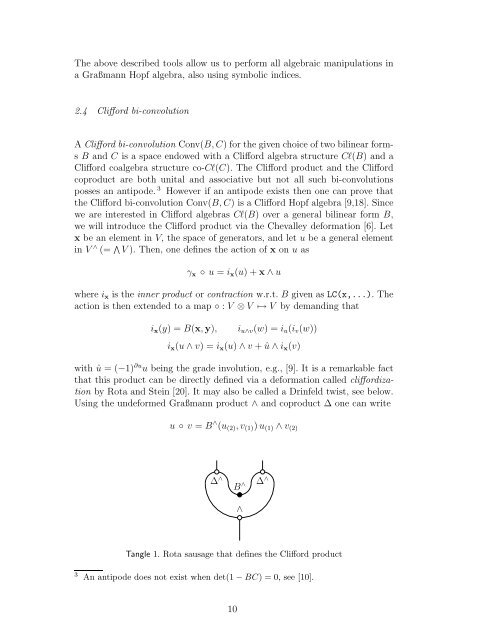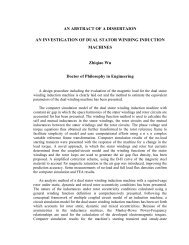CLIFFORD AND GRASSMANN HOPF ALGEBRAS VIA THE ...
CLIFFORD AND GRASSMANN HOPF ALGEBRAS VIA THE ...
CLIFFORD AND GRASSMANN HOPF ALGEBRAS VIA THE ...
Create successful ePaper yourself
Turn your PDF publications into a flip-book with our unique Google optimized e-Paper software.
The above described tools allow us to perform all algebraic manipulations in<br />
a Graßmann Hopf algebra, also using symbolic indices.<br />
2.4 Clifford bi-convolution<br />
A Clifford bi-convolution Conv(B,C) for the given choice of two bilinear forms<br />
B and C is a space endowed with a Clifford algebra structure Cℓ(B) and a<br />
Clifford coalgebra structure co-Cℓ(C). The Clifford product and the Clifford<br />
coproduct are both unital and associative but not all such bi-convolutions<br />
posses an antipode. 3 However if an antipode exists then one can prove that<br />
the Clifford bi-convolution Conv(B,C) is a Clifford Hopf algebra [9,18]. Since<br />
we are interested in Clifford algebras Cℓ(B) over a general bilinear form B,<br />
we will introduce the Clifford product via the Chevalley deformation [6]. Let<br />
x be an element in V, the space of generators, and let u be a general element<br />
in V ∧ (= � V ). Then, one defines the action of x on u as<br />
γx ◦ u = ix(u)+x ∧ u<br />
where ix is the inner product or contraction w.r.t. B given as LC(x,...). The<br />
action is then extended to a map ◦ : V ⊗ V ↦→ V by demanding that<br />
ix(y) =B(x, y), iu∧v(w) =iu(iv(w))<br />
ix(u ∧ v) =ix(u) ∧ v +û ∧ ix(v)<br />
with û =(−1) ∂u u being the grade involution, e.g., [9]. It is a remarkable fact<br />
that this product can be directly defined via a deformation called cliffordization<br />
by Rota and Stein [20]. It may also be called a Drinfeld twist, see below.<br />
Using the undeformed Graßmann product ∧ and coproduct ∆ one can write<br />
u ◦ v = B ∧ (u(2),v(1)) u(1) ∧ v(2)<br />
∆ ∧ ∆ ∧<br />
B ∧<br />
Tangle 1. Rota sausage that defines the Clifford product<br />
3 An antipode does not exist when det(1 − BC) = 0, see [10].<br />
10<br />
∧
















